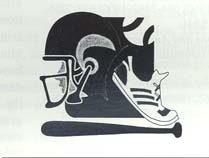

During the fall of 1996, Gabriel Lane, a 20-year-old Denver High School senior with Down syndrome, was prohibited from playing on the Greeley Central football team because of his age. The Colorado High School Activities Association (CHSAA) prohibits players older than 19 from participating in high school sports to protect younger and smaller players from physical injuries.
But under Colorado's special education program, students with disabilities may remain in school until age 21. Lane's lawyer, John Culver, sought a temporary restraining order. He argued that "under Title n of the Americans with Disabilities Act (ADA) the CHSAA must make reasonable modifications in their policies to accommodate students with disabilities unless they can prove the modification(s) will fundamentally alter the nature of the program."
U.S. District Judge Zita Weinshienk denied the motion for a temporary restraining order because the CHSAA rules are based on age and have nothing to do with the disability of the person. Weinshienk also qoted in her judgment that the court should not be the party who micromanages all athletic rules, and it is not about to take over rule-making for the CHSAA. She suggested, however, the CHSAA consider modifying its rules by enabling students with disabilities to participate in interscholastic sports until their 21st birthday (Gabriel Lane v. CHSAA), No. 96-Z-2143, Colorado, 1996).
Shortly after the court's decision, the CHSAA's Executive Committee held a special meeting and voted 11-0 to modify the 19-year-old age rule enabling Gabriel Lane to play football and participate in swimming. The new rule states that "The commissioner can make an exception to any of the CHSAA rules provided the student will not have an unfair impact on the outcome of a game or effect the safety of players."
Because of the Lane case, an additional step was taken in Colorado to assure that all students can participate in interscholastic activities. On March 28, 1997, Governor Roy Romer signed into law Senate Bill 97153. The bill, the first of its kind in the nation, authorizes any student determined to be ineligible to participate in extra-curricular activities to appeal the decision. A student can submit hislher issue to binding arbitration requiring a final decision within 30 days.
In a similar case, an Oklahoma. court agreed with the Colorado court decision that age restriction is a necessary and essential requirement. The Oklahoma court also found that the age limit is uniformly imposed by the Oklahoma Secondary School Activities Association (OSSAA) and that challenging such a policy does not constitute a reasonable modification under Title II of the ADA (Independent School District No.6 of Craig County, Oklahoma and Tracy Autry v. OSSAA No. 97-C-97-B, Oklahoma, 1997).
The opposite decision, however, was rendered in a Connecticut case. The plaintiffs filed suit under the Rehabilitation Act and the ADA which sought a waiver of the age rule of the Connecticut Interscholastic Athletic Conference (CIAC). It was contended that the CIAC received indirect federal assistance and was subject to the Rehabilitation Act. It was also argued that athletic participation was specified on the student's Individualized Education Plan (IEP) and, therefore, was required by federal law. In the court's consideration of the plaintiffs request for a preliminary injunction it was noted that "although there is no constitutional right to participate in inter-scholastic sports, it has been held that inclusion of such activity in an IEP transforms it into a federally protected right" (Dennin v. CIAC Inc., 913F. Supp. 663, Connecticut, 1996).
Recently, Herb Appenzeller, editor of From the Gym to the Jury (Volume 8, Number 4, 1997), has noted that "the age rule usually setting 19 years of age as the standard has been highly controversial for years... The key factor in these cases according to ADA guidelines appears to be the treating of each case not arbitrarily but according to its merits."
Nevertheless, careful planning and persistent efforts on the parts of students with disabilities and their families can help to assure their participation. Three strategies that may prove helpful to professionals are: (a) inclusion of interscholastic athletics on students' IEPs, (b) modification of state high school athletic association age rules which will permit governing bodies to consider extraordinary circumstances, and (c) passage of state legislation that will enable students with disabilities to appeal decisions made by their state high school athletic association. Which,if any, of these strategies might prove helpful in your school district and at the state level.